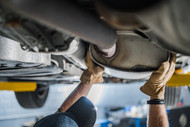Maintaining Your Catalytic Converter to Ensure Compliance in California
17th Sep 2025
If you drive in California, keeping your catalytic converter in top condition is more than just smart vehicle care—it’s the law. A California-approved catalytic converter is specifically designed to meet the strict guidelines set by the California Air Resources Board (CARB). These converters help reduce harmful emissions, protect air quality, and ensure your vehicle passes mandatory inspections. Failing to maintain your converter can lead to costly fines, failed smog checks, and even legal penalties, so taking a proactive approach is essential for both compliance and performance.
CARB Compliance and California Emissions Standards
California is known for having some of the most rigorous California emissions standards in the country. These regulations are designed to reduce pollutants such as nitrogen oxides, carbon monoxide, and hydrocarbons, which contribute to smog and environmental damage. CARB-compliant converters are built to meet higher efficiency levels than federal models, meaning not just any catalytic converter will be acceptable for your vehicle in this state.
Understanding California Emissions Laws
California emissions laws require that any replacement converter installed on your car be CARB-certified and labeled accordingly. It’s illegal to install a non-compliant unit, even if it meets federal EPA standards. Additionally, converters must match your vehicle’s specific make, model, and year, and must be installed by a licensed professional. Regular emissions testing ensures your car meets these legal thresholds, and if your catalytic converter fails, you will be required to replace it before your vehicle can be registered or driven legally.
Catalytic Converter Maintenance Essentials
A catalytic converter is designed to last for many years, but like any component, it can degrade prematurely without proper care. Staying on top of catalytic converter maintenance not only extends its life but also helps maintain compliance with state regulations.
Oil Changes, Tune-Ups, and Exhaust Checks
Routine oil changes prevent contaminants from entering the exhaust system, which can clog or damage the converter. Similarly, timely tune-ups ensure your engine is running efficiently, reducing the risk of unburned fuel reaching the converter and causing overheating. It’s also important to have regular exhaust inspections to catch any leaks, cracks, or other damage that could impact performance. Detecting and addressing small issues early can prevent expensive repairs or the need for a full catalytic converter replacement.
Driving Habits to Avoid Catalytic Converter Replacement
The way you drive plays a big role in your converter’s lifespan. Hard acceleration, sudden braking, and frequent short trips can all contribute to faster wear. When you only drive short distances, the converter doesn’t reach the high operating temperatures needed to burn off carbon deposits, which can lead to blockages over time.
If your check engine light comes on or you notice reduced performance, don’t ignore it—engine problems can quickly escalate into the need for a costly catalytic converter replacement. Smooth, steady driving combined with proper vehicle warm-up helps keep the converter operating efficiently for years.
Preventative Measures for Long-Term Performance
In addition to good driving habits, there are several preventative measures that can keep your converter in peak condition. Using high-quality fuel reduces the risk of harmful buildup inside the exhaust system. Avoid using fuel additives unless recommended by your manufacturer, as some chemicals can damage the converter’s delicate internal structure.
Promptly addressing engine issues, such as misfires or coolant leaks, is also critical. When these problems go unresolved, they can send unburned fuel or contaminants into the converter, causing it to overheat or fail prematurely. By combining smart maintenance with careful driving, you can avoid unnecessary repairs and maintain compliance with California emissions standards year after year.
Staying Compliant and Protecting Your Investment
Your catalytic converter is not just a piece of equipment—it’s your ticket to staying on the road legally in California. By understanding California emissions laws, committing to regular catalytic converter maintenance, and practicing good driving habits, you can extend the life of your converter and protect your investment.
A proactive approach saves you money in the long run by avoiding fines, failed smog checks, and the high cost of a new converter. Most importantly, it helps keep California’s air cleaner and healthier for everyone. Take regular care of your catalytic converter, and it will help maintain your compliance and performance for years to come.

